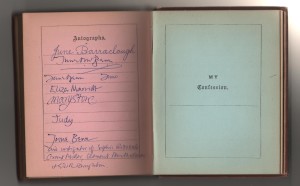 Here’s an oddity that turned up recently at Jot HQ. The Querist’s Album: a Book for Confessions and Autographs (Glasgow, n.d., but c 1880) is a pocket-sized tome comprising several sets of pages meant for autographs together with questions addressed to the person supplying the autographs. All the questions are the same.
Here’s an oddity that turned up recently at Jot HQ. The Querist’s Album: a Book for Confessions and Autographs (Glasgow, n.d., but c 1880) is a pocket-sized tome comprising several sets of pages meant for autographs together with questions addressed to the person supplying the autographs. All the questions are the same.
The questions are obviously addressed to young people—perhaps those in their late teens or early twenties. In this particular copy only around half the pages are filled and many responses date from the late Victorian or Edwardian period. One of those from this era was the actual owner of the book, one M.E.Laxton, who was given it by her aunt.
Most of those supplying an autograph have also answered the questions. However, Miss Laxton dodged many of them and appears to have found some impertinent, including one asking if she was ever in love. A few have merely signed their names, but have left the question pages blank. One anonymous male has only answered a handful of the questions. When asked what is the most beautiful thing in Nature he has replied ‘ Woman ‘, and when asked at what age should men and women marry replies 45 for a man and 60 for a woman. This person also confesses to having been married twice and been in love thirteen times. Another male, a Mr Grant Miller, replies to the questions in what appears to be a ballpoint pen, even though he dates his answers to 1910. His ideal woman is Sophia Ridsdale. Then we have ‘Edith Broughton’, who also uses a ball point pen for her answers dating from April 1905. A further respondent is ‘Clement Bartholomew’.
Most of those completing the questionnaire appear to be women, and of these women the eighteen year-old Sophie Rose Ridsdale stands out. Dating her replies to 1907, Miss Ridsdale confesses that her ideal man was ‘ a genius ‘, her idea of the greatest earthly happiness was ‘ requited love ‘,the vice she most detested was ‘ narrow mindedness, her favourite amusement was ‘ bicycling ‘ and her favourite historical hero and heroine were Lord Nelson and Boudica respectively. Miss Ridsdale also, rather controversially, admired the figure of Satan in Paradise Lost, loved reading George Meredith and Keats, and ( no surprise here) believed Mrs Pankhurst to be ‘ the greatest living orator ‘. Some idea of her feisty, independent character is apparent in her choice of Wagner as her favourite composer and her belief that young men of her time were ‘ too conventional ‘ and young women ‘ too weak’. She was also drawn to older men, feeling that they should marry at 40 and that women should commit at 25.All this suggests that she was the perfect embodiment of the ‘New Woman’.
Like any New Woman of the time Sophie felt that a lady had no justification in concealing her age and that ladies had a right to ‘ pop the question ‘. We also discover that Miss Ridsdale had been in love ‘ many times ‘, that she preferred men with ‘ dark brown hair and dark eyes, and that her favourite colour was scarlet. Her favourite quotation is ‘ be not afraid’, but when asked what her ‘ pet animal ‘ might be Sophie replies ‘ horse at plough ‘. So presumably she was a country-lover. But there is something suspicious about Miss Ridsdale’s replies. Although she uses a fountain pen, the light blue ink hasn’t faded as it might have done and her literary style is just a little too contrived. How many New Women, for instance, would dare admit that they admired Satan and Wagner ? The truth emerges towards the end of the volume, when, following her own replies to the question, the writer signs herself ‘ June Barraclough ‘. Below this name appears that of June Benn, who explains that she was ‘the instigator of Sophie Ridsdale, Grant Miller, Clement Bartholomew, and Edith Broughton’ . The two Junes, it seems, were one and the same person. June Benn was a novelist who was born June Barraclough in 1930.In 1959 she married David Wedgwood Benn, brother of the famous Labour politician Anthony, and in 1985 she published her first novel at the late age of 55. A year later, as we have seen, she decided to test her literary skills by inventing four Edwardian personas and inscribing their thoughts in her copy of the Querist’s Album.
To us at Jot HQ, this is the first example of a novelist creating characters within the bounds of a printed ‘ Confessions ‘ book such as the Querist’s Album. There may be other instances where this has occurred and we’d like to hear of them from Jot fans out there. As for June Benn, she continued to produce a further twenty-four romantic and family history novels until her death at the age of 75. Perhaps Sophia, Edith and the others appeared in some of them. A Yorkshire woman, who had studied Modern languages at Oxford, she was said to have had a ‘great sense of humour and fun ‘, to have loved Dickens and poetry, and to have been a vociferous supporter of the grammar school system. In fact she was a contributor to the infamous Black Paper on education of 1969, along with Rhodes Boyson and Brian Cox. I wonder how thatwent down with Wedgie Benn!
More relevantly, she kept a ‘writer’s notebook ‘from childhood.
[R.M.Healey.]
